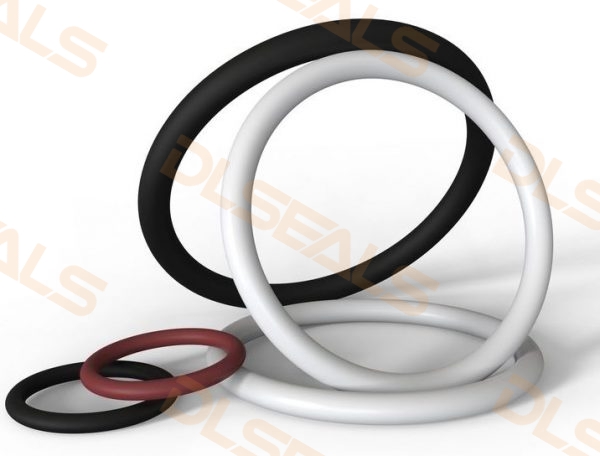In industrial sectors such as chemicals, oil and gas, pharmaceuticals, and energy, equipment often operates under extreme conditions. The combination of high temperature, high pressure, and a strong alkaline medium represents one of the most severe tests for a sealing system. The correct selection of sealing rings (e.g., O-rings) is paramount, directly impacting production safety, environmental compliance, and long-term operational stability. This guide provides a scientific and rigorous methodology for selecting seals for these critical applications.
1. Analysis of Challenges in Extreme Conditions
A deep understanding of the synergistic challenges posed by this environment is the first step in selection:
- Degradation from High Temperature: Elevated temperatures cause polymer materials to harden, become brittle, and lose elasticity (increase compression set), leading to a loss of sealing force. Furthermore, temperature significantly accelerates chemical attack, roughly doubling the reaction rate for every 10-15°C increase, which intensifies the corrosive effect of alkaline media.
- Mechanical Challenges from High Pressure: High pressure can cause softer seal materials to extrude into the microscopic gaps between metal components, resulting in nibbling, tearing, and ultimate failure. It also demands materials with high mechanical strength and tear resistance.
- Chemical Attack from Alkaline Media: Alkalis can cause saponification, breaking down the polymer chains of certain elastomers (like standard nitrile rubber), leading to swelling, softening, and disintegration. Even without saponification, absorption of the medium can cause excessive swelling, degrading physical properties.
The combination of these factors creates a synergistic effect where the total degradation is far greater than the sum of its parts. Material selection must, therefore, meet all three challenges simultaneously.
2. Scientific Evaluation of Core Candidate Materials
No single elastomer is perfect for all applications; selection is a balance of properties, performance, and cost. The following high-performance elastomers are the primary candidates for this extreme service, each with distinct advantages and limitations.
The pinnacle of chemical resistance is Perfluoroelastomer (FFKM). It offers unmatched resistance to virtually all chemicals, including hot, concentrated caustics, and excels in thermal stability, with a continuous service temperature up to 300°C and beyond. Its primary limitation is its extremely high cost, and it generally has lower mechanical strength and elasticity compared to other elastomers. FFKM is the ultimate choice for the most critical applications where failure is not an option.
A more mainstream high-end solution is Peroxide-cured Fluoroelastomer (FKM). It provides an excellent balance of high-temperature resistance (up to ~230°C) and resistance to a broad range of chemicals, including many alkaline media, at a more reasonable cost than FFKM. A critical distinction must be made: peroxide-cured FKM possesses significantly better alkali resistance than standard bisphenol-cured FKM. Its limitations include susceptibility to certain hot, concentrated alkalis, amines, esters, and ketones. It is essential to consult compatibility charts for the specific FKM compound and your medium.
For moderately high temperatures (up to ~150°C), Hydrogenated Nitrile Butadiene Rubber (HNBR) is a robust candidate. It offers excellent resistance to oils and fuels, good mechanical strength, and, importantly, far superior resistance to alkalis compared to standard nitrile rubber. It is a cost-effective choice for alkaline environments that also involve hydrocarbons, though its chemical and temperature range is narrower than that of FKM.
If the medium is strictly alkaline and aqueous with no hydrocarbon presence, Ethylene Propylene Diene Monomer (EPDM) is an outstanding and economical option. It exhibits excellent resistance to hot water, steam, and a wide range of alkalis, with good elasticity and low compression set. However, its fatal flaw is poor resistance to petroleum-based oils and lubricants, which cause severe swelling.
While not an elastomer, Polytetrafluoroethylene (PTFE), known as the “plastic king,” must be considered for its supreme chemical inertness. It is virtually unaffected by any concentration of alkali at temperatures up to 260°C. However, being a thermoplastic, it lacks elasticity and is typically used in modified forms (e.g., filled PTFE) or designed as V-rings or spring-energized seals to function effectively.
3. A Methodical Selection Process
A scientific approach minimizes risk and ensures success:
- Define Operating Parameters Precisely: Document the exact alkali type and concentration, maximum and continuous temperatures, maximum pressure including any surges, and determine if the seal is static or dynamic.
- Prioritize Material Compatibility Testing: The gold standard is to conduct immersion tests. Expose samples of the candidate materials to the actual service medium at the expected temperature and pressure for a prolonged period (e.g., 168 hours). Post-test, evaluate key metrics:
- Volume Change (ΔV%): Ideally should remain within ±10%. Significant swelling or shrinkage indicates incompatibility.
- Hardness Change (ΔShore A): Indicates the stability of the material’s properties.
- Change in Tensile Strength and Elongation: Measures the degradation of mechanical integrity.
- Consider System Design and Seal Configuration: In high-pressure applications, the use of anti-extrusion rings (e.g., made from PTFE) is mandatory to prevent the seal from being forced into gaps. The seal gland design must have minimal clearance. Selecting a harder seal compound (e.g., Shore A 90) can also improve extrusion resistance.
4. Summary and Final Recommendations
There is no universal seal material for high-temperature, high-pressure alkaline environments. The choice is a calculated decision based on specific parameters.
- For the most severe conditions (hot, concentrated caustics) where cost is secondary to reliability, FFKM is the definitive choice.
- For a broad range of demanding alkaline services, Peroxide-cured FKM represents the best balance of performance and cost and is the most common high-performance selection.
- For alkaline environments with hydrocarbons at temperatures below 150°C, HNBR offers excellent value and performance.
- For hot water, steam, and alkali applications strictly free of oils, EPDM is a highly effective and economical solution.
Final Advisory: Avoid selection by anecdote. Base decisions on manufacturer data sheets and, whenever possible, real-world testing. Collaborate with reputable seal suppliers and material scientists to navigate these extreme conditions successfully. The correct selection is not just a technicality—it is a fundamental pillar of operational safety and asset protection.
Post time: Oct-08-2025

